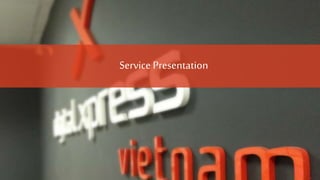
Service Presentation
- 2. • Goods are something that you can use or consume. Goods are owned by the purchaser and can be used once or repeatedly. Goods are always tangible property. • Examples of Goods: Books , CDs Foodstuff Furniture Real Estate Printers, computers and computer hardware Vehicle, etc.
- 3. • Services are actions or an action that someone does for you. Services are intangible property since you don’t receive anything solid and you don’t obtain ownership of the actions taken. The purchaser of a services gets something needed but does not own any tangible, solid or fixed property. • Examples of Services: Use licenses – permission to use property of another (this includes software licenses) Consultant services; Labor to install, assemble, dismantle, adjust, repair, or maintain tangible property Labor to install, configure, modify or upgrade a computer program Maintenance contracts; contracts for service (but not the purchase of a warranty agreement itself)
- 4. • The four I’s of services Intangibility – Physical Evidence Inseparability Inconsistency Inventory - Perishability Process People
- 5. • Services are activities, experiences -not things • But very often you need things to provide services Transportation services needs busses, trams, trains, plains Health care services needs hospitals, syringes, stethoscopes, beds Fast food Services needs tables, seats
- 6. • No service can be provided without the participation of the customer! Interactive customer Interactive producer (employee) Some parts of the service require interaction Some parts of the service do not require interaction • Different services require a different intensiveness of interaction.
- 7. Source: Kasper et al.(1999): Services Marketing Management, S. 11
- 8. • The customer is an essential part of the service production process. Standardization of services is difficult on many occasions!
- 9. • Services are intangible and therefore can not be stored • The more intangible a service is, the more problematic is its storage
- 14. InteractionProduct Characteristics Loyalty Satisfaction = Perception – Expectation Quality TimePrice
- 15. • This indicates: In the service industry, quality is not absolute nor relative to contractual obligations, it is relative to the performance believed to be available from competitors. Improvement can be gained by managing the expectations of customers without any change in performance. Service Quality = Perception – Expectation
- 16. CustomerDXP
